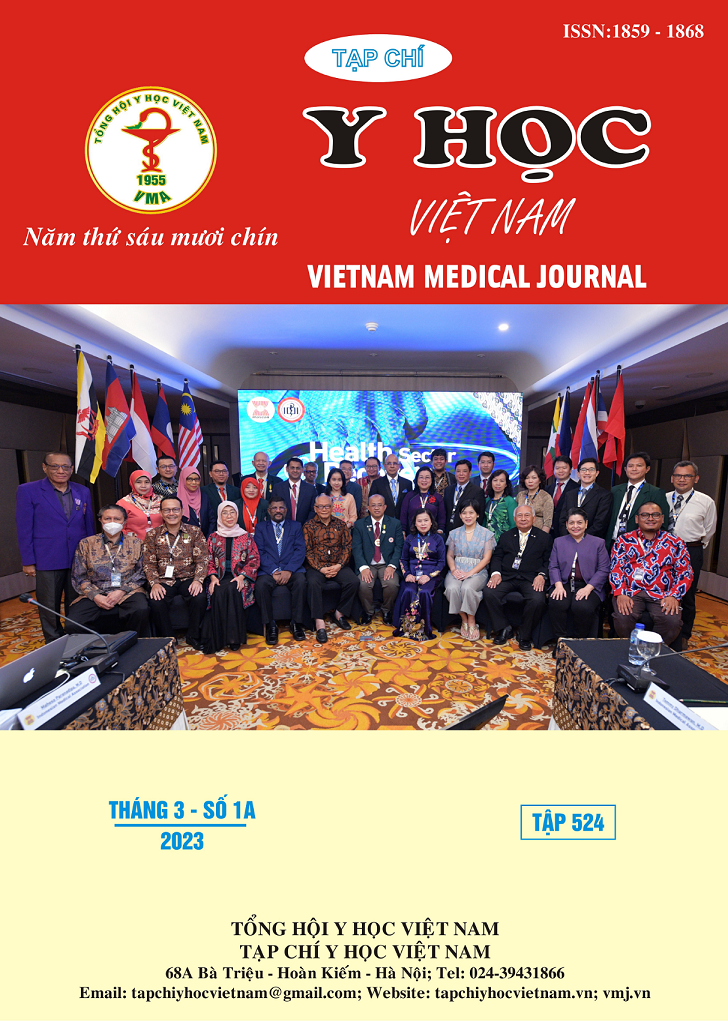SO SÁNH ĐẶC ĐIỂM HÌNH HÌNH ẢNH X QUANG THƯỜNG QUI, CẮT LỚP VI TÍNH VÀ CỘNG HƯỞNG TỪ LAO CỘT SỐNG TRÊN 60 BỆNH NHÂN LAO CỘT SỐNG ĐƯỢC PHẪU THUẬT TẠI BỆNH VIỆN PHỔI TRUNG ƯƠNG
Nội dung chính của bài viết
Tóm tắt
Mục tiêu nghiên cứu mô tả và so sánh đặc điểm hình ảnh X quang thường qui, chụp cắt lớp vi tính và cộng hưởng từ lao cột sống được phẫu thuật tại bệnh viện Phổi trung ương. Cỡ mẫu 60 bệnh nhân. Phương pháp hồi cứu, mô tả, cắt ngang. Tuổi TB: 58 ± 15,6; nam/nữ: 1,3/1; Thời gian chẩn đoán được lao cột sống tính từ khi có triệu chứng < 2 tháng: 43,3%; Giải phẫu bệnh viêm lao điển hình (91,7%). Nuôi cấy BACTEC/MGIT dương tính MTB 95%; LPA bệnh phẩm có MTB 80%. Tổn thương cột sống thắt lưng 51,7%; Cột sống ngực 33,3%; Cột sống cổ 8,3%; Tổn thương 2 thân đốt liền kề 75%; Tổn thương > 2 thân đốt 15,6%. X quang thường qui: mất đường cong sinh lý 80%; Huỷ thân đốt 76,7%; Hẹp khe liên đốt 58,3%; Thân đốt hình chêm 43,3%; Áp xe trong dây chằng sống 18,3%. Cắt lớp vi tính: mất đường cong sinh lý 80%; Huỷ thân đốt 85%; Hẹp khe liên đốt 58,3%; Thân đốt hình chêm 41,7%; Áp xe cơ đái chậu 45,0%; Chèn ép tuỷ 30,0%. Cộng hưởng từ: mất đường cong sinh lý 76,7%; Huỷ thân đốt 81,7%; Hẹp khe liên đốt 53,3%; Thân đốt sống hình chêm 43,3%; Áp xe trong dây chằng sống 20%; Áp xe cơ đái chậu 50%; Chèn ép tuỷ 21,0%; Viêm thân đốt 58,3%; Huỷ đĩa đệm 41,7%. So sánh tỷ lệ % khả năng phát hiện một số dấu hiệu điển hình của lao cột sống của các kỹ thuật XQ, CT, MRI cho thấy một số khác biệt có ý nghĩa thống kê. Kết luận CHT có vai trò nổi trội trong chẩn đoán hình ảnh lao cột sống.
Chi tiết bài viết
Từ khóa
Lao cột sống; Xquang thường qui cột sống; Cộng hưởng từ lao cột sống; Cắt lớp vi tính lao cột sống.
Tài liệu tham khảo
2. Trần Văn Việt. Kỹ thuật chụp cộng hưởng từ. Nhà XBYH. 2015. p: 253-326.
3. Phạm Minh Thông và CS. Chẩn đoán hình ảnh cộng hưởng từ toàn thân. Nhà XB Đại học Huế. 2019. p: 3-36; 227-278.
4. Naselli N, Facchini G, Lima GM, et al. MRI in differential diagnosis between tuberculous and pyogenic spondylodiscitis. Eur Spine J Off Publ Eur Spine Soc Eur Spinal Deform Soc Eur Sect Cerv Spine Res Soc. 2022;31(2):431-441. doi:10.1007/s00586-021-06952-8
5. Lee CM, Lee Y, Kang SJ, et al. Positivity rates of mycobacterial culture in patients with tuberculous spondylitis according to methods and sites of biopsies: An analysis of 206 cases. Int J Infect Dis. 2022;121:161-165. doi:10.1016/j.ijid.2022.05.02
6. Karthek V, Bhilare P, Hadgaonkar S, et al. Gene Xpert/MTB RIF assay for spinal tuberculosis- sensitivity, specificity and clinical utility. J Clin Orthop Trauma. 2021;16:233-238. doi:10.1016/ j.jcot.2021.02.006
7. Role of percutaneous transpedicular biopsy in diagnosis of spinal tuberculosis and its correlation with the clinico-radiological features - PubMed. Accessed October 23, 2022. https://pubmed.ncbi. nlm.nih. gov/31439185
8. Kanna RM, Babu N, Kannan M, Shetty AP, Rajasekaran S. Diagnostic accuracy of whole spine magnetic resonance imaging in spinal tuberculosis validated through tissue studies. Eur Spine J Off Publ Eur Spine Soc Eur Spinal Deform Soc Eur Sect Cerv Spine Res Soc. 2019; 28(12): 3003-3010. doi:10.1007/s00586-019-06031-z
9. Deng R. Difference of CT and MRI in Diagnosis of Spinal Tuberculosis. Zhongguo Yi Liao Qi Xie Za Zhi. 2015;39(4):302-303.


